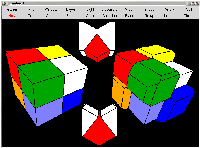
Normal and weighted Voronoi tesselation of a water molecule and a
cube of different atoms (H, O, N, C, P, Si, Na... in increasing order
of covalent radius, with colors white, red, light blue, green, orange,
yellow, blue... respectively), always with periodic boundary conditions.
Larger atoms have larger polyhedra in weighted (radical) Voronoi
tesselation, changing completely the topology of the system.
Normal and weighted tesselation systems are shown at the same
scale, with a perspective projection.
Size: 23,985 bytes.
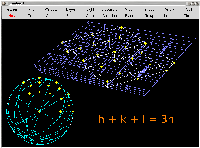
Reciprocal lattice and stereographic projection of a rhombohedral (hR) lattice
(a = 1.0 c = 3.0), showing the planes (the yellow crosses) and directions
(the green traces). The reciprocal lattice of the corresponding primitive (hP)
lattice is also shown (in blue). In a hR lattice, planes with conventional
indices must obbey the rule -h+k+l = 3n, which explains the absence of the
other planes. The pole close to the center of the stereographic projection
is the plane (003), which is above the origin (the node without plane)
in the reciprocal lattice.
Size: 37,089 bytes.
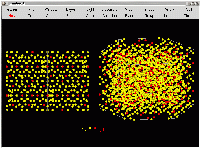
Atomic structure of Al4Cr intermetallic compound, belonging to the
hexagonal P6_3/mmc (194) space group, in perspective (right) and along
direction [001] (left). Each cell (a = 1.998 nm, c = 2.467 nm,
beta = 119.3 degrees) shows 1800 atoms, corresponding to 563 atoms
inside the hexagonal prism, 453 of Al and 110 of Cr. Atoms partially
in yellow and red correspond to positions statistically occupied
by atoms of both elements, so the sum of the two occupancy numbers
is 1.0. From Amélia Almeida, PhD thesis. Size: 80,443 bytes.
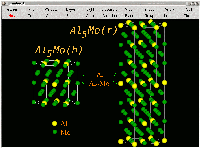
Atomic structure of high- (above 800 C) and low-temperature (below 648 C)
allotropic phases of Al5Mo intermetallic compound, Al5Mo(h) and Al5Mo(r),
respectively. Al5Mo(h) has a hP lattice (a = 0.4912 nm, c = 0.8860 nm,
space group = P6_3 = 173) while Al5Mo(r) is rombohedral (a = 0.4951 nm,
c = 2.6231 nm, space group = R-3c = 167). From Amélia Almeida, PhD thesis.
Size: 65,670 bytes.
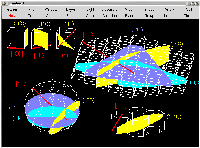
Crystallographic planes and directions in: 1) an orthorhombic body-centered
lattice (a = 3.1 Angstrom, b = 3.0 Angstrom, c = 1.0 Angstrom), represented
by a spherical volume (r = 5.0 Angstrom) and by 5 x 5 x 5 Wigner-Seitz cells;
2) the three cubic lattices (c = 1.0 Angstrom); 3) the hexagonal lattice
(a = 1.0 Angstrom, c = 1.633 Angstrom). Size: 34,537 bytes.
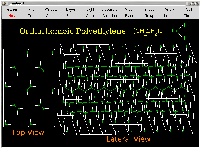
2 x 10 x 2 conventional cells (a = 748 pm, b = 255 pm, c = 497 pm)
for orthorhombic high-density polyethylene (space group = 62,
Wyckoff positions: 1) C c 0.0330, 0.0660; 2) H c 0.1898, 0.0520;
3) H c 0.0339, 0.2607). Chains (CH2)n are aligned along direction b
(instead of direction c, as usual), to use the standard space
group Pnma (instead of Pnam), as defined in the International
Tables for Crystallography. Crystalline polyethylene can also
be obtained experimentally with monoclinic symmetry
(space group 12 = C2/m). Size: 25,763 bytes.
 Normal and weighted Voronoi tesselation of a water molecule and a
cube of different atoms (H, O, N, C, P, Si, Na... in increasing order
of covalent radius, with colors white, red, light blue, green, orange,
yellow, blue... respectively), always with periodic boundary conditions.
Larger atoms have larger polyhedra in weighted (radical) Voronoi
tesselation, changing completely the topology of the system.
Normal and weighted tesselation systems are shown at the same
scale, with a perspective projection.
Size: 23,985 bytes.
Normal and weighted Voronoi tesselation of a water molecule and a
cube of different atoms (H, O, N, C, P, Si, Na... in increasing order
of covalent radius, with colors white, red, light blue, green, orange,
yellow, blue... respectively), always with periodic boundary conditions.
Larger atoms have larger polyhedra in weighted (radical) Voronoi
tesselation, changing completely the topology of the system.
Normal and weighted tesselation systems are shown at the same
scale, with a perspective projection.
Size: 23,985 bytes.
 Reciprocal lattice and stereographic projection of a rhombohedral (hR) lattice
(a = 1.0 c = 3.0), showing the planes (the yellow crosses) and directions
(the green traces). The reciprocal lattice of the corresponding primitive (hP)
lattice is also shown (in blue). In a hR lattice, planes with conventional
indices must obbey the rule -h+k+l = 3n, which explains the absence of the
other planes. The pole close to the center of the stereographic projection
is the plane (003), which is above the origin (the node without plane)
in the reciprocal lattice.
Size: 37,089 bytes.
Reciprocal lattice and stereographic projection of a rhombohedral (hR) lattice
(a = 1.0 c = 3.0), showing the planes (the yellow crosses) and directions
(the green traces). The reciprocal lattice of the corresponding primitive (hP)
lattice is also shown (in blue). In a hR lattice, planes with conventional
indices must obbey the rule -h+k+l = 3n, which explains the absence of the
other planes. The pole close to the center of the stereographic projection
is the plane (003), which is above the origin (the node without plane)
in the reciprocal lattice.
Size: 37,089 bytes.
 Atomic structure of Al4Cr intermetallic compound, belonging to the
hexagonal P6_3/mmc (194) space group, in perspective (right) and along
direction [001] (left). Each cell (a = 1.998 nm, c = 2.467 nm,
beta = 119.3 degrees) shows 1800 atoms, corresponding to 563 atoms
inside the hexagonal prism, 453 of Al and 110 of Cr. Atoms partially
in yellow and red correspond to positions statistically occupied
by atoms of both elements, so the sum of the two occupancy numbers
is 1.0. From Amélia Almeida, PhD thesis. Size: 80,443 bytes.
Atomic structure of Al4Cr intermetallic compound, belonging to the
hexagonal P6_3/mmc (194) space group, in perspective (right) and along
direction [001] (left). Each cell (a = 1.998 nm, c = 2.467 nm,
beta = 119.3 degrees) shows 1800 atoms, corresponding to 563 atoms
inside the hexagonal prism, 453 of Al and 110 of Cr. Atoms partially
in yellow and red correspond to positions statistically occupied
by atoms of both elements, so the sum of the two occupancy numbers
is 1.0. From Amélia Almeida, PhD thesis. Size: 80,443 bytes.
 Atomic structure of high- (above 800 C) and low-temperature (below 648 C)
allotropic phases of Al5Mo intermetallic compound, Al5Mo(h) and Al5Mo(r),
respectively. Al5Mo(h) has a hP lattice (a = 0.4912 nm, c = 0.8860 nm,
space group = P6_3 = 173) while Al5Mo(r) is rombohedral (a = 0.4951 nm,
c = 2.6231 nm, space group = R-3c = 167). From Amélia Almeida, PhD thesis.
Size: 65,670 bytes.
Atomic structure of high- (above 800 C) and low-temperature (below 648 C)
allotropic phases of Al5Mo intermetallic compound, Al5Mo(h) and Al5Mo(r),
respectively. Al5Mo(h) has a hP lattice (a = 0.4912 nm, c = 0.8860 nm,
space group = P6_3 = 173) while Al5Mo(r) is rombohedral (a = 0.4951 nm,
c = 2.6231 nm, space group = R-3c = 167). From Amélia Almeida, PhD thesis.
Size: 65,670 bytes.
 Crystallographic planes and directions in: 1) an orthorhombic body-centered
lattice (a = 3.1 Angstrom, b = 3.0 Angstrom, c = 1.0 Angstrom), represented
by a spherical volume (r = 5.0 Angstrom) and by 5 x 5 x 5 Wigner-Seitz cells;
2) the three cubic lattices (c = 1.0 Angstrom); 3) the hexagonal lattice
(a = 1.0 Angstrom, c = 1.633 Angstrom). Size: 34,537 bytes.
Crystallographic planes and directions in: 1) an orthorhombic body-centered
lattice (a = 3.1 Angstrom, b = 3.0 Angstrom, c = 1.0 Angstrom), represented
by a spherical volume (r = 5.0 Angstrom) and by 5 x 5 x 5 Wigner-Seitz cells;
2) the three cubic lattices (c = 1.0 Angstrom); 3) the hexagonal lattice
(a = 1.0 Angstrom, c = 1.633 Angstrom). Size: 34,537 bytes.
 2 x 10 x 2 conventional cells (a = 748 pm, b = 255 pm, c = 497 pm)
for orthorhombic high-density polyethylene (space group = 62,
Wyckoff positions: 1) C c 0.0330, 0.0660; 2) H c 0.1898, 0.0520;
3) H c 0.0339, 0.2607). Chains (CH2)n are aligned along direction b
(instead of direction c, as usual), to use the standard space
group Pnma (instead of Pnam), as defined in the International
Tables for Crystallography. Crystalline polyethylene can also
be obtained experimentally with monoclinic symmetry
(space group 12 = C2/m). Size: 25,763 bytes.
2 x 10 x 2 conventional cells (a = 748 pm, b = 255 pm, c = 497 pm)
for orthorhombic high-density polyethylene (space group = 62,
Wyckoff positions: 1) C c 0.0330, 0.0660; 2) H c 0.1898, 0.0520;
3) H c 0.0339, 0.2607). Chains (CH2)n are aligned along direction b
(instead of direction c, as usual), to use the standard space
group Pnma (instead of Pnam), as defined in the International
Tables for Crystallography. Crystalline polyethylene can also
be obtained experimentally with monoclinic symmetry
(space group 12 = C2/m). Size: 25,763 bytes.